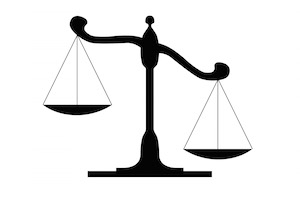Weight is a big deal in weightlifting. Yeah, that’s a “duh” kind of sentence, but for once I don’t mean what’s on the bar.
Scale weight, specifically, YOUR scale weight, is a big deal, too.
Weightlifting is a sport divided by weight classes. So how much you weigh determines in which of the 8 men’s classes or 7 women’s classes you will lift. Somewhat obviously the shorter you are and the heavier you are within a given weight class, the more you will likely lift because you’ll have proportionately more muscle and shorter lever arms to move the weight.
For masters athletes, weight classes can be a particularly painful subject. While it it’s generally true that the heavier you are the more you lift, as a proportion you would lift more with additional weight if that weight were primarily made up of muscle, not fat. A combo of fat and muscle still makes you stronger, but there is a point of diminishing returns if the majority of any body weight you add is only fat.
Masters are going to have a much harder time putting on a higher ratio of muscle than fat. Assuming your supplements don’t end in the letters “-ol” or “-one” and have to be injected with a needle, then your hormone levels ain’t what they used to be. And without the hormonal signal to tell your body to take all that protein you eat and turn it into quadz, then extra calories will put on some muscle but almost always with a fat component, too.
Dieting off the excess fat to make a certain class without strength losses is also a little tougher the older you get. Metabolisms slow (although not as much as sedentary age matched cohorts! Go us!) with advancing age, so the habit of living above your weight class and dieting down before competition can be tricksy at best.
The human body is about 60% water if you’re a lean man, 55% water if you’re a woman (women are statistically less lean than men and fat carries less water within it than lean tissue). This can be manipulated to change the scale number for weigh-in without sacrificing muscle mass, but there are limits to how much you can dehydrate in a week and not compromise performance. The powerlifters that weigh-in 24 hours before have a huge advantage over us in this unfortunately, since we only have 1-2 hours between weigh-in and lifting.
So if you started playing this game later in life, you may not be coming in with the percentage of muscle that the folks who have been lifting since they were 12 get to have. I’m not saying it’s impossible to build muscle past a certain age – that would be absurd. But you may have to accept a higher body fat percentage and scale weight to go with all your shiny new muscle.
For many of us this may be a socially hard pill to swallow. I consciously gave up my 102lb, size 0 self to bulk up to 117lbs of lots of muscle. That was a 15% increase in body weight. The transformation took about 18 months. Six months for the scale to change to 117, 12 or so months to recomp -slowly- all that extra weight into muscle.
While a lot of my clothes still fit, not all do. An argument could be made that what fits, fits a lot better with juicy quadz and a booty to fill them out, but if twiggy women are your jam, then you’re SOL with me. At my height (5’1.75″) if I could get up to 58kg with a lot of muscle, I’d be thrilled. But my concern is that most of that extra scale weight wouldn’t be muscle at my age and I wouldn’t be competitive in that class. I’d just be bigger and need a whole new wardrobe and get my ass kicked every time I hit a platform.
But having said that, I will caution first time competitors about getting too wrapped up in all of this. My advice to first timers and for people not competing to qualify for a national or international event is to not worry about it at all. Let the chips fall where they may. Eat a great dinner the night before, and you weigh what you weigh the next day. There will be enough stress involved in figuring out the flow of a meet, of conquering nerves on the platform and wearing a singlet in public. You don’t need to walk in HANGRY and dehydrated, too.
If you like to geek out on statistics, check out the data HERE on All Things Gym. It’s a compilation of all the heights and weights of the senior lifters at the 2012 olympics. Again, I’m not sure you can use it as gospel for what you should weigh to be competitive at a given height as a master, but it’s interesting nonetheless.
